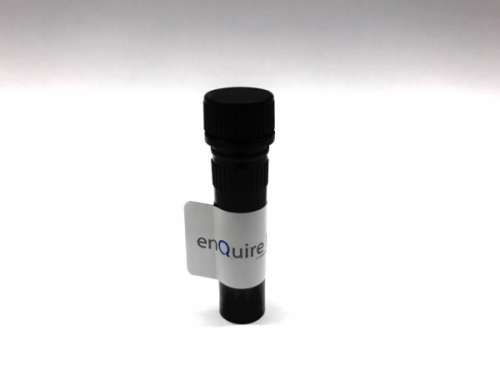Human Spliceosome RNA helicase DDX39B Recombinant Protein Product Attributes
Product Type: Recombinant Protein
Recombinant Spliceosome RNA helicase DDX39B based upon sequence from: Human
Host: QP8315 protein expressed in E. coli.
Tag: GST
Protein Construction: A DNA sequence encoding the Homo sapiens (Human) Spliceosome RNA helicase DDX39B, was expressed in the hosts and tags indicated. Please select your host/tag option, above.
Application Notes: Please contact us for application specific information for QP8315.
Bioactivity Data: Untested
Full Length? Partial (see sequence information for more details).
Expression Region: Ala2 – Val251
Amino Acid Sequence: AENDVDNELL DYEDDEVETA AGGDGAEAPA KKDVKGSYVS IHSSGFRDFL LKPELLRAIV DCGFEHPSEV QHECIPQAIL GMDVLCQAKS GMGKTAVFVL ATLQQLEPVT GQVSVLVMCH TRELAFQISK EYERFSKYMP NVKVAVFFGG LSIKKDEEVL KKNCPHIVVG TPGRILALAR NKSLNLKHIK HFILDECDKM LEQLDMRRDV QEIFRMTPHE KQVMMFSATL SKEIRPVCRK FMQDPMEIFV
Purity: Greater than 90% as determined by SDS-PAGE.
Reconstitution Instructions:
Concentration of Human Spliceosome RNA helicase DDX39B Protein:
Endotoxin Levels: Not determined.
Buffer: Tris-based buffer, 50% glycerol
Storage Conditions: Store at -20C to -80C.
| Recombinant Human Spliceosome RNA helicase DDX39B Protein General Information | |
|---|---|
| Alternate Names | |
| D6S81E; UAP56; BAT1 | |
| Curated Database and Bioinformatic Data | |
| Gene Symbol | DDX39B |
| Entrez Gene ID | 7919 |
| Ensemble Gene ID | ENSG00000215425 |
| RefSeq Protein Accession(s) | NP_004631.1 |
| RefSeq mRNA Accession(s) | NM_004640.6, NM_080598.5 |
| UniProt ID(s) | Q13838 |
| UniGene ID(s) | Hs.254042 |
| HGNC ID(s) | HGNC:13917 |
| COSMIC ID Link(s) | DDX39B |
| KEGG Gene ID(s) | hsa:7919 |
| PharmGKB ID(s) | PA25262 |
| General Description of Recombinant Human Spliceosome RNA helicase DDX39B Protein. | |
| Involved in nuclear export of spliced and unspliced mRNA. Assbling component of the TREX complex which is thought to couple mRNA transcription, processing and nuclear export, and specifically associates with spliced mRNA and not with unspliced pre-mRNA. TREX is recruited to spliced mRNAs by a transcription-independent mechanism, binds to mRNA upstream of the exon-junction complex (EJC) and is recruited in a splicing- and cap-dependent manner to a region near the 5′ end of the mRNA where it functions in mRNA export to the cytoplasm via the TAP/NFX1 pathway. May undergo several rounds of ATP hydrolysis during assbly of TREX to drive subsequent loading of components such as ALYREF/THOC and CHTOP onto mRNA. The TREX complex is essential for the export of Kaposi’s sarcoma-associated herpesvirus (KSHV) intronless mRNAs and infectious virus production. Also associates with pre-mRNA independent of ALYREF/THOC4 and the THO complex. Involved in the nuclear export of intronless mRNA; the ATP-bound form is proposed to recruit export adapter ALYREF/THOC4 to intronless mRNA; its ATPase activity is cooperatively stimulated by RNA and ALYREF/THOC4 and ATP hydrolysis is thought to trigger the dissociation from RNA to allow the association of ALYREF/THOC4 and the NXF1-NXT1 heterodimer. Involved in transcription elongation and genome stability.Splice factor that is required for the first ATP-dependent step in spliceosome assbly and for the interaction of U2 snRNP with the branchpoint. Has both RNA-stimulated ATP binding/hydrolysis activity and ATP-dependent RNA unwinding activity. Even with the stimulation of RNA, the ATPase activity is weak. Can only hydrolyze ATP but not other NTPs. The RNA stimulation of ATPase activity does not have a strong preference for the sequence and length of the RNA. However, ssRNA stimulates the ATPase activity much more strongly than dsRNA. Can unwind 5′ or 3′ overhangs or blunt end RNA duplexes in vitro. The ATPase and helicase activities are not influenced by U2AF2; the effect of ALYREF/THOC4 is reported conflictingly with [PubMed:23299939] reporting a stimulatory effect. | |
Limitations and Performance Guarantee
This is a life science research product (for Research Use Only). This product is guaranteed to work for a period of two years when stored at -70C or colder, and one year when aliquoted and stored at -20C.




There are no reviews yet.